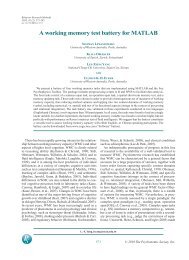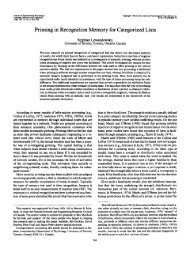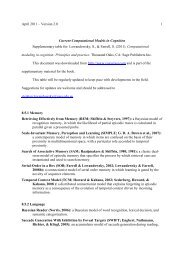Context effects in repetition priming are sense effects
Context effects in repetition priming are sense effects
Context effects in repetition priming are sense effects
You also want an ePaper? Increase the reach of your titles
YUMPU automatically turns print PDFs into web optimized ePapers that Google loves.
620 BAINBRIDGE, LEWANDOWSKY, AND KIRSNER<br />
Experiments us<strong>in</strong>g lexical decision or other more datadriven<br />
tasks, <strong>in</strong> contrast, have produced a more diverse<br />
pattern. A useful taxonomy of these studiesdist<strong>in</strong>guishes<br />
between the different ways <strong>in</strong> which context was manipulated:<br />
Some experiments provided context at study, but<br />
not at test, and reported no differential <strong>effects</strong> of context<br />
(see, e.g., Jacoby, 1983), whereas others used s<strong>in</strong>gle<br />
words to manipulate context and obta<strong>in</strong>ed rather mixed<br />
outcomes (see, e.g., Carroll & Kirsner, 1982; Masson<br />
& Freedman, 1990). We argue that there may be methodological<br />
reasons for preferr<strong>in</strong>gthe latter class of studies<br />
and that the rema<strong>in</strong><strong>in</strong>g empirical discrepancies can be<br />
resolved by us<strong>in</strong>g a more extensiveand concise manipulation<br />
of context.<br />
Consider experiments <strong>in</strong> which context was provided<br />
at study but not at test (see, e.g., Allen & Jacoby, 1990;<br />
Blaxton, 1989; Jacoby, 1983; Levy & Kirsner, 1989;<br />
MacLeod, 1989; Oliphant, 1983). When s<strong>in</strong>gle words<br />
formed the context manipulation, as <strong>in</strong> Jacoby’s (1983)<br />
experiment, study items were accompanied by various<br />
cues—for example, an antonym (HOT-COLD) or a related<br />
item (SNow—CoLD) versus a neutral letter pattern<br />
(xxx—C0LD). At a later test, with words <strong>in</strong> isolation<br />
(COLD), less prim<strong>in</strong>g was observed for the antonym and<br />
related conditions than for the neutral condition. Similarly,<br />
when study items were part of a mean<strong>in</strong>gful text,<br />
prim<strong>in</strong>g on a later isolated presentation was m<strong>in</strong>imal<br />
(MacLeod, 1989) or absent (Levy& Kirsner, 1989; Ohphant,<br />
1983). However, rather than conclud<strong>in</strong>g on the<br />
basis of these data that study context disrupts implicit<br />
memory for <strong>in</strong>dividual words, we argue that the forego<strong>in</strong>g<br />
studies may have failed to f<strong>in</strong>d beneficial <strong>effects</strong> of context<br />
by not re-present<strong>in</strong>g it at test. In Jacoby’s experiment,<br />
for example, there is no way of know<strong>in</strong>g whether<br />
reprocess<strong>in</strong>g COLD at test, <strong>in</strong>the presence of SNOW, might<br />
nothave led to greater facilitation than was observed when<br />
COLD was tested <strong>in</strong> isolation.<br />
Turn<strong>in</strong>g to studies that provided contextual cues at study<br />
and test, Carroll and Kirsner (1982) def<strong>in</strong>ed context as<br />
the co-occurrence of two words <strong>in</strong> a pair and showed that<br />
<strong>repetition</strong> of context can facilitate lexical decision over<br />
and above mere <strong>repetition</strong> of the stimulus words, provided<br />
that the items <strong>in</strong> repeated pairs were preexperimentally<br />
associated. When the items <strong>in</strong> a pair were not preexperimentahly<br />
related, <strong>in</strong> contrast, <strong>repetition</strong> of the <strong>in</strong>tact<br />
pair provided no more prim<strong>in</strong>g than when the items were<br />
rearranged across different pairs. More recently, Smith,<br />
MacLeod, Ba<strong>in</strong>, and Hoppe (1989) reported two experiments<br />
us<strong>in</strong>g unrelated pairs <strong>in</strong> which <strong>repetition</strong> prim<strong>in</strong>g,<br />
albeit across short retention <strong>in</strong>tervals, was equal for both<br />
<strong>in</strong>tact and rearranged pairs. Taken together, the studies<br />
show that when context is provided by a s<strong>in</strong>glecue word,<br />
and when the context-target pairs <strong>are</strong> preexperimentally<br />
unrelated, manipulations of context appear tohave <strong>in</strong>consequential<br />
<strong>effects</strong>.<br />
In contrast, Masson and Freedman (1990, Experiment<br />
2) reported a strong effect of chang<strong>in</strong>g the perceived<br />
mean<strong>in</strong>g of a word between study and test. Their design<br />
was similar to that of Carroll and Kirsner (1982), except<br />
that s<strong>in</strong>gle words were tested, all targets were homographs,<br />
and, similar to Smith et al. (1989), the <strong>in</strong>tervals<br />
between <strong>repetition</strong>s were short (15 items). The context<br />
word biased a particular mean<strong>in</strong>g of the target homograph.<br />
Whenthe cue differed at test, but biased the same mean<strong>in</strong>g,<br />
a smaller reduction <strong>in</strong> <strong>repetition</strong> prim<strong>in</strong>g was observed<br />
(<strong>in</strong> comparison with the same-cue condition) than<br />
when the context biased the alternative mean<strong>in</strong>g. Thus,<br />
Masson and Freedman’s (1990) data show that context<br />
can affect the mean<strong>in</strong>g that is selected for encod<strong>in</strong>g a<br />
repeated item and that re<strong>in</strong>stat<strong>in</strong>g a particular niean<strong>in</strong>g<br />
does not depend on the <strong>repetition</strong> of a particular contexttarget<br />
pair.<br />
The forego<strong>in</strong>gexperiments suggest that <strong>repetition</strong> prim<strong>in</strong>g<br />
of predom<strong>in</strong>antly data-driven tasks tends to be <strong>in</strong>sensitive<br />
to changes <strong>in</strong> context, with the specific exception<br />
that <strong>repetition</strong> prim<strong>in</strong>g can be elim<strong>in</strong>ated by alter<strong>in</strong>g the<br />
perceived mean<strong>in</strong>g of a homograph. In part, the general<br />
context <strong>in</strong>sensitivity may have resulted from the use of<br />
s<strong>in</strong>glecue words to manipulate context—we propose that<br />
a more satisfactory control can be obta<strong>in</strong>ed by the use of<br />
sentences. It has been shown that selective activation of<br />
the context-appropriate mean<strong>in</strong>g of a homograph—that is,<br />
understand<strong>in</strong>g COUNT to mean “duke’ ‘-couNT—occurs<br />
only if the preced<strong>in</strong>g context sentence is sufficiently constra<strong>in</strong><strong>in</strong>g.<br />
For example, COUNT would be constra<strong>in</strong>ed by<br />
“Thevampire was disguisedas a handsome COUNT” but<br />
not by “The k<strong>in</strong>g kept los<strong>in</strong>g trackof the COUNT” (Simpson,<br />
1981). By analogy, it seems likely that a s<strong>in</strong>gle word<br />
context, such as that used by Masson and Freedman<br />
(1990), is less likely to impose a specific contextual <strong>in</strong>terpretation<br />
that delimits the mean<strong>in</strong>g of a stimulus.<br />
Moreover, even for nonhomographs, numerous experiments<br />
have shown that the specific <strong>sense</strong> 1 carried by a<br />
word <strong>in</strong> a sentence context is more restricted than is the<br />
<strong>in</strong>terpretation of the same word presented alone or with<br />
a s<strong>in</strong>gle word cue (see, e.g., Anderson & Ortony, 1975;<br />
Glucksberg, Kreuz, & Rho, 1986; O’Seaghdha, 1989;<br />
Sanocki & Oden, 1984; Schuberth, Spoehr, & Lane,<br />
1981; Tabossi, 1988; Tabossi & Johnson-Laird, 1980).<br />
To illustrate, consider one of Tabossi’s (1988, Experiment<br />
2) studies, which showed that lexical decisions were<br />
facilitated only when the target was related to a contextrelevant<br />
property of a preced<strong>in</strong>g sentence-f<strong>in</strong>al noun. For<br />
example, responses to FAT would be facilitated by the preced<strong>in</strong>g<br />
sentence, “To follow her diet, the woman elim<strong>in</strong>ated<br />
the use of BUTTER.” This facilitation must have<br />
reflected the specific l<strong>in</strong>guistic context provided by the<br />
sentence, as opposed to some more general semantic prim<strong>in</strong>g<br />
between BUTTER and FAT, because facilitation of FAT<br />
was absent <strong>in</strong> sentences such as, “To soften it, the woman<br />
heated the piece of BUTTER,” which focused on properties<br />
of BUTTER not relevant to the target.<br />
If one concludes that selection of a specific nuance or<br />
<strong>sense</strong> of a word demands the presence of a strong, sentential<br />
context, it follows that the failure to f<strong>in</strong>d any systematic<br />
context <strong>effects</strong> <strong>in</strong> implicit memory (see, e.g.,





